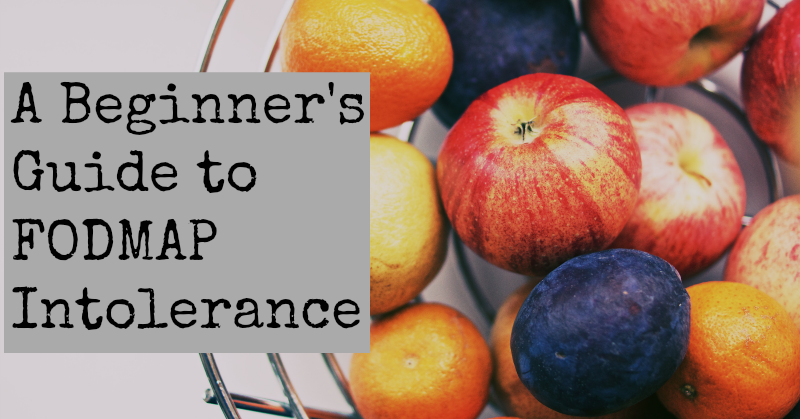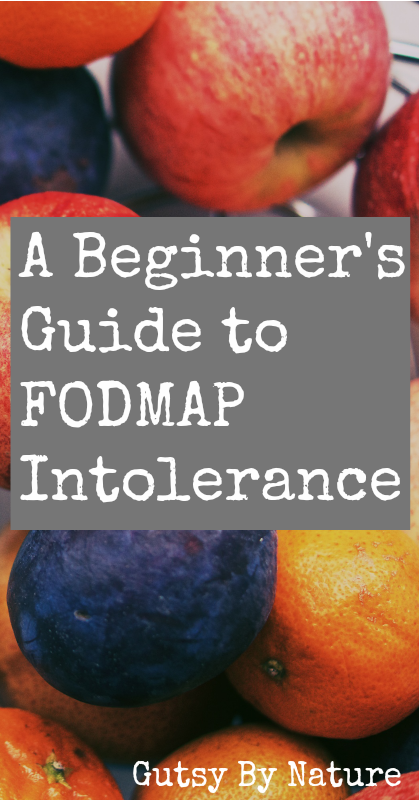
If you have Crohn’s disease then you may have heard of a group of carbohydrates referred to as FODMAPs, especially if you happen to live in Australia where the bulk of the research into these foods has occurred and a low-FODMAP diet has gained widespread acceptance as treatment for people with both irritable bowel syndrome (IBS) and inflammatory bowel diseases (IBD). If you aren’t familiar with the term or what a low-FODMAP diet would entail, this post intends to help clear up confusion.
What does FODMAP stand for?
F – Fermentable, O – Oligosaccarides, D – Disacharides, M – Monosaccharides, A – and, P – Polyols
These include lactose, fructose, oligos (fructans and galactans), and polyols (sorbitol and mannitol). Foods that are high-FODMAP contain one or more of these compounds.
That’s the technical answer, but unless you are really fascinated by the science, it isn’t all that important to understand what those odd words mean. Though if you do want more technical detail, I recommend the The Complete Low-FODMAP Diet by Sue Shepherd of the Monash University, or for a more paleo-oriented perspective check out Digestive Health with Real Food by registered dietician Aglaee Jacob.
What do FODMAPs do?
People who are sensitive to FODMAPs may experience bloating, abdominal pain, diarrhea, constipation, and/or gas when they consume them. So, pretty much the whole gamut of digestive problems! They are also associated with fatigue, lethargy, nausea, heartburn, and acid reflux – though we don’t really know if those are a result of the FODMAPs or come along with the territory of the active underlying disease.
Which foods are low in FODMAPs?
I wrote a post on this a while back where I listed fruits and vegetables that are both low in FODMAPs and acceptable to eat when following a paleo autoimmune protocol (AIP). Included on this list are the following vegetables: carrots, cucumbers, green beans, kale, lettuce, okra, parsnips, pumpkin, radishes, spinach, zucchini and other summer squash; and the following fruits: bananas, blueberries, cantaloupe, grapes, honeydew melons, kiwi, oranges and other citrus fruits, pineapple, raspberries and rhubarb.
If you are not on AIP, you have a few additional low-FODMAP options that are acceptable on a standard paleo diet.
Some dairy products
Lactose is the sugar found in milk and if your body does not produce the enzyme that breaks it down, you will experience symptoms when it is fermented in your intestines. This is what is known as “lactose intolerance.” Not all dairy products contain significant amounts of lactose. For example, ghee and butter have virtually none as does yogurt that has been fermented for 24 hours or more. You may also be able to consume heavy cream and eat some hard cheeses.
Nightshades
It seems like such a poetic injustice, but most of the nightshades that provoke immune responses and are eliminated on AIP are actually low-FODMAP foods. If you do not have a nightshade sensitivity, you may be able to eat eggplants, peppers, tomatoes, and white potatoes.
Nuts and seeds
A few nuts and seeds are high in FODMAPs, but the following are good choices: macadamia nuts, pecans, pine nuts, chia seeds, pumpkin seeds, sesame seeds, sunflower seeds, and walnuts.
“Safe starches”
As mentioned earlier, white potatoes are low-FODMAP and so is white rice. Both should be eliminated on an AIP diet and some people who eat paleo stay away from them as well, but from a FODMAP perspective they are a good choice.
Which foods are high in FODMAPs?
Many fruits and vegetables that are part of a very healthy diet for most people turn our guts into knots due to their FODMAP content. Some people with Crohn’s disease and other digestive concerns react to all of these but most people find through trial and error that they can eat some of them in small to moderate quantities. Also, many people find that over time their FODMAP tolerance improves (especially if the underlying gut problems heal) and they can eventually add them back into their diet.
To navigate this without doing a bunch of trial and error, it can be helpful to know which foods are high in which types of FODMAPs. That way you know that if you are able to eat a food that is high in one type, you might be able to tolerate others with a similar makeup. I have listed below the fruits, vegetables, and nuts that are generally high-FODMAP and indicated which type they contain large quantities of. This will help you determine, for example, that if you can comfortably eat blackberries, you might also be able to eat avocados, peaches, cauliflower, celery, mushrooms, peas, and sweet potatoes since all of these are only high in polyols but low in the other types.
Other foods will take more detective work because they contain multiple types. For example, if apricots make you feel bad it might be due to the oligos or the polyols. And keep in mind that quantity matters! For example, if you are sensitive to fructose, even relatively low fructose foods may make you ill if you eat too much of them.
Fruit
| Oligos | Fructose | Polyols | |
| Apples | X | X | |
| Apricots | X | X | |
| Avocados | X | ||
| Blackberries | X | ||
| Cherries | X | X | |
| Grapefruit | X | ||
| Mango | X | ||
| Nectarine | X | X | |
| Peach | X | ||
| Pear | X | X | |
| Watermelon | X | X | X |
Vegetables
| Oligos | Fructose | Polyols | |
| Artichoke | X | ||
| Asparagus | X | ||
| Beets | X | ||
| Cauliflower | X | ||
| Celery | X | ||
| Garlic | X | ||
| Leek | X | ||
| Mushrooms | X | ||
| Onions | X | ||
| Peas | X | ||
| Sweet Potatoes | X |
Nuts
| Oligos | Fructose | Polyols | |
| Almonds | X | ||
| Cashews | X | ||
| Pistachios | X |
A note on FODMAP content lists. If you poke around on the internet a bit, you are going to see a great deal of contradiction. The science for determining FODMAP content is imperfect and analysis is ongoing. I defer to the Monash University as they have been doing this the longest and continue to revise their recommendations. You can purchase the book by Sue Shepherd, order their brochure, or purchase an interactive iPhone app to stay up to date (that’s what I use). Be aware however that the Monash Low-FODMAP diet is not paleo and will recommend lots of foods that I would not eat, including some grains and legumes.
Disclaimer: This content is not intended to diagnose or treat any medical condition, but provide general information ONLY. You should discuss your unique medical needs with your own practitioner.
Please sign up for my weekly email newsletter to be the first to know about all my latest offerings and news!
Click to Pin It!




17 replies on “FODMAPs and Crohn’s Disease: A Beginner’s Guide”
[…] Low-FODMAP: Omit the shallots and do not include the optional mushrooms. […]
[…] Low-FODMAP: Use maple syrup in place of the honey. […]
[…] you are eating a “safe starch” paleo diet, Specific Carbohydrate Diet (SCD), the low-FODMAP diet, following a Whole 30, or even on a strict elimination diet like the paleo autoimmune protocol […]
article useful for all readers, I think this would be beneficial
for me and many other readers abt ulcerative
thank you for sharing.
[…] same goes for people following the Specific Carbohydrate Diet (SCD) and Low-FODMAP diets. If you know your restrictions and are comfortable making simple modifications, you will do […]
[…] Low-FODMAP: Unfortunately, the flavor in this recipe is dependent on the onions, garlic, and figs – all of which are high FODMAP ingredients. […]
[…] Omit the onions to make this recipe low-FODMAP. […]
[…] you are following a low-FODMAP diet you will need to omit the onion and garlic. To get a similar flavor, you can use the green part of […]
Did you ever have an issue with fodmaps? I have off and on in the past. I was doing very well but I have suddenly had a resurgence of GI symptoms. I had added dairy back on so that’s gone. I also re-eliminated alcohol. I already wasn’t eating sugar, but had dark chocolate most days so that’s gone for now as well. I also decided to ditch all fruit for the time being, which sucks but I’m strangely having blood glucose issues (I am not diabetic nor have I ever been high risk or had it in my family). I have been tossing going full AIP again and/or low fodmap but man I really don’t want to do it! I’m already back to eliminating things and I’ve done the super restrictive elimination diets so many times, it’s unreal. I am trying to be patient with myself and see if the bloating subsides with the eliminations I have already done. I was just curious if you have had issues and if you know specifically which category. I am thinking it may be oliogos group for me, which of course has the best ones! Haha
The only category that I really have to be careful with is polyols. It explains why apples have always given me issues and why when I started eating cauliflower mash and cauli-rice all the time I was miserable! I actually do much better with real potatoes and real white rice. Just goes to show that one size does not fit all.
[…] Low-FODMAP: Omit the onion and the garlic to make this dish low-FODMAP. You could use the green part of a leek and some garlic oil to approximate the flavor. […]
[…] make low-FODMAP, omit the […]
[…] Low-FODMAP: Omit onions and garlic but use garlic infused olive oil for flavor. […]
[…] written and also conforms with the requirements of the Specific Carbohydrate Diet (SCD). To make it low-FODMAP, you would need to omit the onion and the […]
[…] Low-FODMAPs: Use just the green part of the leeks and discard the white. […]
[…] who have difficulty tolerating many vegetables due to FODMAP intolerance will find that red cabbage is a good low-FODMAP option. However, this dish includes onions, apples, […]
[…] Want to learn more about the different types of FODMAPs? Check out this post. […]